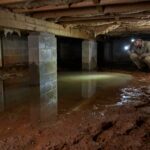Top Strategies for Effective Foundation Repair: Ensuring a Solid Base for Your Home
When it comes to home maintenance, it’s easy to overlook the foundation. After all, it’s out of sight and, unless you live in a cartoon where your house might levitate occasionally, it hardly ever becomes a topic of dinner conversation. However, the truth is that a solid foundation is crucial for the integrity and longevity of your home. If you’ve noticed cracks in your walls or doors that stick like they’re auditioning for a role in a bad sitcom, it might be time to consider foundation repair. In this article, we’ll explore top strategies for effective foundation repair, ensuring your home remains the sturdy fortress you want it to be.
Understanding Your Foundation
Before we dive into repair strategies, let’s take a moment to appreciate what we are working with. Foundations typically come in three main types: slab, crawl space, and basement. Each type has its quirks, benefits, and potential issues. For example, slab foundations provide a solid base but can crack under pressure; crawl spaces might invite the occasional rodent party; and basements—well, they can be as damp as a rainforest if not properly maintained.
Knowing the type of foundation you have will help you understand the specific challenges and solutions that apply. It’s like knowing what kind of pet you have before deciding on whether to feed it dog food or fish flakes. Spoiler alert: don’t feed your pet goldfish any dog food.
Signs of Foundation Trouble
Recognizing the signs of foundation issues can save you from costly repairs down the line. Look out for:
1. **Cracks in Walls and Floors**: Not the “artistic” kind, but rather straight, jagged lines that appear in drywall, plaster, or even your beloved hardwood floors.
2. **Doors and Windows that Don’t Close Properly**: If your front door suddenly resembles a stubborn teenager unable to get out of bed, it might be time to investigate.
3. **Uneven Floors**: If your floors feel like a funhouse attraction, with dips and rises, it could indicate a foundation problem.
4. **Gaps Around Windows and Doors**: If there are gaps large enough to fit a small animal, you might want to reconsider that new pet adoption plan.
5. **Water Pooling Near the Foundation**: Think of this as your foundation throwing a little pool party—without your consent.
If you notice any of these signs, it’s wise to consult a professional who can diagnose the issue rather than playing DIY detective with your trusty magnifying glass.
Top Strategies for Effective Foundation Repair
Now that we know what we’re dealing with, let’s roll up our sleeves and explore some effective strategies for foundation repair. Think of this as your foundational toolkit—some assembly required!
### 1. Waterproofing
Water is often the arch-nemesis of foundations. Too much moisture can lead to soil erosion, which plays a direct role in foundation settling. Waterproofing helps keep your home dry and your foundation intact.
– **External Waterproofing**: This involves digging around your home to expose the foundation walls and applying a waterproof membrane. Just imagine a fancy spa day for your foundation—minus the cucumber slices.
– **Internal Waterproofing**: For those rainy days when water decides to sneak in through basements or crawl spaces, installing a sump pump or moisture barriers can help divert the water and keep it at bay.
### 2. Foundation Slab Jacking
If your slab foundation has sunk, don’t give up hope just yet! Slab jacking is a technique used to raise the foundation back to its original level. This is done by injecting a specialized foam or concrete mixture beneath the slab, filling voids, and lifting it back into place. It’s sort of like giving your foundation an elevator ride back to the penthouse suite.
### 3. Piering & Underpinning
When your foundation is sinking (which sounds alarming, but don’t panic just yet), piering or underpinning may be necessary. This involves installing piers beneath the foundation to stabilize it and prevent further settling.
– **Helical Piers**: These screw-like devices are drilled deep into the ground until they hit stable soil, providing a solid anchor for your home.
– **Steel Push Piers**: Similar to helical piers but driven horizontally into the soil, pushing against the foundation for support. They’re strong and durable, leaving your home feeling like it has a superhero sidekick.
### 4. Grading and Drainage Improvements
Sometimes, just improving the grading and drainage around your home can work wonders. This might involve:
– **Regrading Landscapes**: Ensuring that the ground slopes away from your foundation so that water doesn’t collect around it. Think of it as giving your yard a stylish new contour.
– **Installing French Drains**: These are not just fancy names for drains; they channel water away from the foundation, keeping your home high and dry.
– **Downspout Extensions**: Extending your gutter downspouts can help carry water away from the house, preventing it from pooling near the foundation.
### 5. Regular Maintenance and Inspections
Prevention is key, and regular inspections can help catch issues before they turn into full-blown foundational catastrophes. Aim for annual check-ups, especially after heavy rains or if you notice changes in your home.
– **Look for Signs of Water Damage**: Check your basement, crawl spaces, and exterior for signs of water intrusion.
– **Inspect Landscape Grading**: Ensure that your landscaping continues to slope away from your foundation.
– **Monitor Cracks**: Use a level to monitor any cracks for movement. If they start growing like weeds in a garden, call a professional.
### 6. Engage Professional Help
While some DIY fixes are tempting, there are times when you should leave things to the pros. Foundation repair can be complicated, and improper fixes could exacerbate the problem.
– **Get Multiple Quotes**: Before settling on a contractor, gather multiple quotes and read reviews. You wouldn’t hire a chef without tasting their soufflé first, would you?
– **Check Credentials**: Ensure the company is licensed, insured, and has a good track record. A little research can save you from hefty headaches later on.
### Conclusion: Building a Solid Future
Your foundation is the unsung hero of your home, silently bearing the weight of your dreams, memories, and perhaps a few questionable renovation decisions. By employing effective foundation repair strategies, you can ensure it remains the sturdy base your home needs.
Remember, investing in your foundation today is akin to guarding your future. Trust your instincts, stay vigilant for signs of trouble, and don’t shy away from bringing in the experts when necessary. With the right strategies in place, you can enjoy peace of mind knowing your home is grounded, both literally and figuratively. So go ahead, secure that foundation, and carry on with your life—preferably without an unexpected tilt or a sinking sensation!


